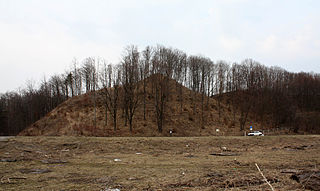Related Research Articles

The Nadruvians were a now-extinct Prussian tribe. They lived in Nadruvia, a large territory in northernmost Prussia. They bordered the Skalvians on the Neman (Nemunas) River just to the north, the Sudovians to the east, and other Prussian tribes to the south and west. Most information about the clan is provided in a chronicle by Peter von Dusburg.
The siege of Christmemel was an unsuccessful siege of the Teutonic Knights' castle of Christmemel by the Grand Duchy of Lithuania in autumn 1315.

The Battle of Durbe was a medieval battle fought near Durbe, 23 km (14 mi) east of Liepāja, in present-day Latvia during the Livonian Crusade. On 13 July 1260, the Samogitians soundly defeated the joint forces of the Teutonic Knights from Prussia and the Livonian Order from Livonia. Some 150 knights were killed, including Livonian master Burkhard von Hornhausen and Prussian land marshal Heinrich Botel. It was by far the largest defeat of the knights in the 13th century: in the second-largest, the Battle of Aizkraukle, 71 knights were killed. The battle inspired the Great Prussian Uprising and the rebellions of the Semigallians, the Couronians, and the Oeselians. The battle undid two decades of Livonian conquests and it took some thirty years for the Livonian Order to restore its control.

The Prussian uprisings were two major and three smaller uprisings by the Old Prussians, one of the Baltic tribes, against the Teutonic Knights that took place in the 13th century during the Prussian Crusade. The crusading military order, supported by the Popes and Christian Europe, sought to conquer and convert the pagan Prussians. In the first ten years of the crusade, five of the seven major Prussian clans fell under the control of the less numerous Teutonic Knights. However, the Prussians rose against their conquerors on five occasions.

The family of Gediminas is a group of family members of Gediminas, Grand Duke of Lithuania, who interacted in the 14th century. The family included the siblings, children, and grandchildren of the Grand Duke and played the pivotal role in the history of Lithuania for the period as the Lithuanian nobility had not yet acquired its influence. Gediminas was also the forefather of the Gediminid dynasty, which ruled the Grand Duchy of Lithuania from 1310s or 1280s to 1572.

The Ostrów or Astrava Agreement was a treaty between Jogaila, King of Poland and Grand Duke of Lithuania, and his cousin Vytautas the Great, signed on 4 August 1392. The treaty ended the destructive Lithuanian Civil War, launched in 1389 by Vytautas who hoped to gain political power, and concluded the power struggle between the two cousins that erupted in 1380 after Jogaila secretly signed the Treaty of Dovydiškės with the Teutonic Knights. The Ostrów Agreement did not stop attacks from the Teutonic Knights and the territorial dispute over Samogitia continued up to 1422. According to the treaty, Vytautas became the ruler of Lithuania, but he also acknowledged Jogaila's rights to Lithuania. The details of the Polish–Lithuanian relationship were clarified in several later treaties, including the Union of Vilnius and Radom in 1401 and Union of Horodło in 1413.

The Treaty of Salynas was a peace treaty signed on 12 October 1398 by Vytautas the Great, the Grand Duke of Lithuania, and Konrad von Jungingen, the Grand Master of the Teutonic Knights. It was signed on an islet of the Neman River, probably between Kulautuva and the mouth of the Nevėžis River. It was the third time, after the Treaty of Königsberg (1384) and Treaty of Lyck (1390), that Vytautas promised Samogitia to the Knights. The territory was important to the Knights as it physically separated the Teutonic Knights in Prussia from its branch in Livonia. It was the first time that the Knights and Vytautas attempted to enforce the cession of Samogitia. However, it did not solve the territorial disputes over Samogitia and they dragged on until the Treaty of Melno in 1422.
Ritterswerder was a short-lived wooden castle built by the Teutonic Order in fall 1391. It was located on an island in the Neman River near Lampėdžiai, now part of the city of Kaunas.
The Treaty of Dubysa or Treaty of Dubissa consisted of three legal acts formulated on 31 October 1382 between Jogaila, Grand Duke of Lithuania, with his brother Skirgaila and Konrad von Wallenrode, Marshal of the Teutonic Order. During the Lithuanian Civil War (1381–84), Teutonic Order helped Jogaila and Skirgaila to defeat their uncle Kęstutis and his son Vytautas. Trying to realize promises given by Jogaila during the war, Teutonic Order organized the negotiations for the treaty. The acts were signed after six days of negotiations on an island in the mouth of the Dubysa River. The treaty was never ratified and never came into effect. The civil war resumed in summer 1383.

The Lithuanian Civil War of 1381–1384 was the first struggle for power between the cousins Jogaila, Grand Duke of Lithuania and later King of Poland, and Vytautas the Great. It began after Jogaila signed the Treaty of Dovydiškės with the Teutonic Knights which was aimed against his uncle Kęstutis, father of Vytautas. Kęstutis briefly seized power in the Grand Duchy, but was betrayed by adherents of Jogaila primarily from Vilnius. During negotiations for a truce Kęstutis and Vytautas were arrested and transported to the Kreva Castle. Kęstutis died there a week later but Vytautas managed to escape and then sought an alliance with the Teutonic Knights. Subsequently their joint forces raided Lithuanian lands. Eventually the cousins were reconciled as Jogaila needed internal stability in anticipation of negotiations with the Grand Duchy of Moscow and the Kingdom of Poland regarding the possible Christianization of Lithuania. The war did not settle the power struggle; it continued during the next Lithuanian Civil War (1389–1392) which was resolved by the signing of the Ostrów Agreement. After more than ten years of struggle, Vytautas finally became the Grand Duke of Lithuania and ruled the country for thirty-eight years.

Samogitian uprisings refer to two uprisings by the Samogitians against the Teutonic Knights in 1401–1404 and 1409. Samogitia was granted to the Teutonic Knights by Vytautas the Great, Grand Duke of Lithuania, several times in order to enlist Knights' support for his other military affairs. The local population resisted Teutonic rule and asked Vytautas to protect them. The first uprising was unsuccessful and Vytautas had to reconfirm his previous promises to transfer Samogitia in the Peace of Raciąż. The second uprising provoked the Knights to declare war on Poland. Hostilities escalated and resulted in the Battle of Grunwald (1410), one of the biggest battles of medieval Europe. The Knights were soundly defeated by the joint Polish–Lithuanian forces, but Vytautas and Jogaila, King of Poland, were unable to capitalize on their victory. Conflicts regarding Samogitia, both diplomatic and military, dragged until the Treaty of Melno (1422).
The Battle of Turaida or Treiden was fought on June 1, 1298, on the banks of the Gauja River near the Turaida Castle. The Livonian Order was decisively defeated by the residents of Riga allied with the Grand Duchy of Lithuania under command of Vytenis.

Gediminas was Grand Duke of Lithuania from 1315 or 1316 until his death in 1341.

Vytenis was the Grand Duke of Lithuania from c. 1295 to c. 1316. He became the first of the Gediminid dynasty to rule for a considerable amount of time. In the early 14th century his reputation outshone that of Gediminas, who is regarded by modern historians as one of the greatest Lithuanian rulers. The rule of Vytenis was marked by constant warfare in an effort to consolidate the Grand Duchy of Lithuania with the Ruthenians, Masovians, and the Teutonic Order.

The siege of Medvėgalis was a brief siege of Medvėgalis, a Lithuanian fortress in Samogitia, in February 1329 by the Teutonic Order reinforced by many guest crusaders, including King John of Bohemia. The 18,000-strong Teutonic army captured four Lithuanian fortresses and besieged Medvėgalis. The fortress surrendered and as many as 6,000 locals were baptized in the Catholic rite. The campaign, which lasted a little more than a week, was cut short by a Polish attack on Prussia in the Polish–Teutonic War (1326–32). As soon as the Teutonic army returned to Prussia the Lithuanians returned to their pagan practices and beliefs.

The siege of Kaunas was laid by the Teutonic Order on the newly built Kaunas Castle in spring 1362. It was the first brick castle built by the Grand Duchy of Lithuania. After a month-long siege, the castle was captured and destroyed. Its commander Vaidotas, son of Kęstutis, and 36 others were taken captive. The defeat, followed by the destruction of Veliuona and Pieštvė the following year, severely weakened Lithuanian defenses along the Neman River and opened central Lithuania to Teutonic attacks.

The Lithuanian Crusade was a series of campaigns by the Teutonic Order and the Livonian Order under the pretext of forcibly Christianizing the pagan Grand Duchy of Lithuania. The Livonian Order occupied Riga in 1202 and in the 1230s they settled in Chełmno Land, a fief of Poland. They first conquered other neighboring Baltic tribes—Curonians, Semigallians, Latgalians, Selonians, and Old Prussians—in the Livonian Crusade and Prussian Crusade.

Pieštvė was a wooden fortress of the Grand Duchy of Lithuania during the Lithuanian Crusade. It stood on a hill fort that is known as Palemon Hill in Seredžius, Jurbarkas District Municipality, Lithuania, located near the confluence of the Neman and Dubysa rivers. It was an important Lithuanian defensive outpost against the Teutonic Order. It was first mentioned in written sources in 1293 and attacked numerous times by the Order. Because it stood near Junigeda (Veliuona), both fortresses were often attacked together. It was burned down in 1363, a year following the fall of Kaunas Castle. It was rebuilt in May 1412 but lost its strategic importance after the Treaty of Melno (1422) and was abandoned. Earlier historians thought that Pieštvė was identical to Bisena.

Bisenė or Bisena was a wooden fortress of the Grand Duchy of Lithuania during the Lithuanian Crusade. It was one of the Lithuanian defensive outposts along the Neman River and was burned down by the Teutonic Order in 1283 and 1316. Its location was long debated and often confused with Pieštvė, but after 1985 research of Romas Batūra it has been generally accepted to be Kartupėnai Hillfort near the confluence of the Kartupis and Neman in Jurbarkas District Municipality, Lithuania. After the burning down of Kolainiai in 1291 and Bisenė in 1316, Junigeda (Veliuona) became the westernmost Lithuanian fortress along the Neman.
The Battle of Wopławki or Woplauken was fought on 7 April 1311 in the area near the village of Woplauken, north-east of Kętrzyn. Belorusian historian Ruslan Gagua states in Annalistic Records on the Battle of WopławkiArchived 2020-06-26 at the Wayback Machine The battle definitely had become a major and significant one by medieval standards during the military confrontation of the Teutonic Order and the then Lithuania, according to The Nature of the Conduct of Warfare in Prussian and Lithuanian Borderlands at the Turn of the 13th and 14th Centuries by Ruslan Gagua.
References
- 1 2 3 "Kristmemelis". Gynybiniai įtvirtinimai (XIII-XVIII a.) (in Lithuanian). Society of Lithuanian Archaeology. Archived from the original on 2016-03-03. Retrieved 2010-07-16.
- 1 2 Zinkus, Jonas; et al., eds. (1985–1988). "Christmemelis". Tarybų Lietuvos enciklopedija (in Lithuanian). Vol. 1. Vilnius: Vyriausioji enciklopedijų redakcija. p. 322. LCCN 86232954.
- 1 2 Pakštas, Kazys (1933–1944). "Christmemelio pilis". In Biržiška, Vaclovas (ed.). Lietuviškoji enciklopedija (in Lithuanian). Vol. 5. Kaunas: Spaudos Fondas. pp. 858–859. LCCN 37032253.
- 1 2 Jankauskas, Vytas (2008). "Nemuno žemupio pilių gynybinės sistemos efectyvumas kovose su vokiečių ordinu 1283–1369 metais" (PDF). Karo Archyvas (in Lithuanian): 12, 17. ISSN 1392-6489. Archived from the original (PDF) on 2012-03-03. Retrieved 2010-07-16.
- 1 2 Urban, William (2006). Samogitian Crusade. Chicago: Lithuanian Research and Studies Center. pp. 66–67. ISBN 0-929700-56-2.
- 1 2 Zabiela, Gintautas (1995). Lietuvos medinės pilys (in Lithuanian). Vilnius: Diemedis. p. 251. ISBN 9986-23-018-7.